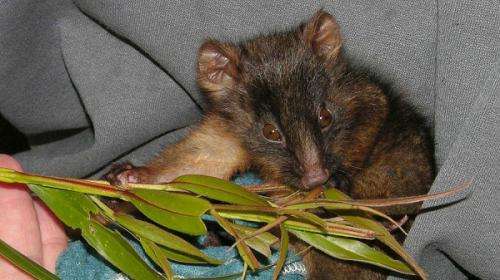Predators outweigh disease in possum threats

A study looking at pathogen transmission during the translocation of endangered western ringtail possums (Pseudocheirus occidentalis) has provided an insight into assessing the disease risk for populations.
The research from Murdoch University was published in the Journal of Wildlife Diseases and looked at translocations in WA's South West and any infectious diseases that might compromise possum survival.
Dr Judy Clarke, one of the study's authors, says there have been few known instances in the past—but disease has not always been considered during translocations so undetected instances of pathogen transmission may have occurred.
"The concern is high because consequences could be disastrous," she says.
"Screening for disease and disease risk assessments are recommended for all animal translocations by the International Union for Conservation of Nature.
"We were somewhat surprised at the lack of evidence of possum exposure to the diseases we tested for because we know pathogens including toxoplasma and crypotoccus are found in other species and/or the environment in the area.
"But it was encouraging to find disease was not a limiting factor for translocation success in this study.
"Predation by native and introduced predators – pythons, raptors, foxes and cats – was much more significant and resulted in low translocation success overall."
Dr Clarke's research involved screening wild and captive possums where she also found values for neutrophil count, total solids protein, fibrinogen, alanine amino-transferase, aspartate aminotrans- ferase (AST), creatinine kinase (CK), bilirubin, cholesterol, protein, urea and globulin were lower for captive possums while alkaline phosphatase was higher.
She believes nutritional factors may explain most of the differences.
"Captive animals cannot select foliage quality and are likely to have diets lower in protein and available nitrogen, resulting in lower blood values for protein- and nitrogen-breakdown products," Dr Clarke says.
"Their diets are often supplemented with fruit and flowers which increase their blood glucose.
"Enzymes elevated during stress include AST and CK and wild Pseudocheirus occidentalis are likely to produce higher levels of these enzymes following capture than captive individuals used to people."
The haematological and serum biochemical reference ranges will provide baseline information for future health studies of possums and can also be useful for evaluating the health and prognosis for possums being rehabilitated after injury or illness.
"The negative disease results, although encouraging in terms of translocation outcomes, do indicate possums in this area may be particularly susceptible to introductions of these diseases in the future," Dr Clarke says.
More information:
"Hematologic and serum biochemical reference ranges and an assessment of exposure to infectious diseases prior to translocation of the threatened Western ringtail possum (pseudocheirus occidentalis)."
Clarke J, Warren K, Calver M, de Tores P, Mills J, Robertson I. J Wildl Dis. 2013 Oct;49(4):831-40. DOI: 10.7589/2011-12-345.
Provided by Science Network WA

















